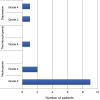Pediatric melanoma and aggressive Spitz tumors: a retrospective diagnostic, exposure and outcome analysis
- PMID: 30159246
- PMCID: PMC6087836
- DOI: 10.21037/tp.2018.01.03
Pediatric melanoma and aggressive Spitz tumors: a retrospective diagnostic, exposure and outcome analysis
Abstract
Background: The diagnosis and management of pediatric melanomas is challenging given the presence of both melanomas and histologically aggressive Spitz tumors of undetermined biological significance (S-UBS) in this age group. Study objectives were to examine: factors leading to diagnostic delays, therapy side effects and patient outcomes in these diagnostic groups.
Methods: A retrospective case review was performed using The University of Michigan's pediatric oncology database over a 13-year timespan. Patients referred to our clinic for consideration of interferon therapy due to a diagnosis of a stage III melanoma or aggressive appearing S-UBS with significant lymph node involvement were included.
Results: We found two major causes of diagnosis delay: patients with amelanotic lesions misdiagnosed as having a wart and cases reviewed by non-expert pathologists upfront. The side effects from interferon therapy requiring dose adjustments included neutropenia, thrombocytopenia and mood disturbances. There was wide variability in surveillance scan utilization, therefore leading to variability in patient radiation exposure. Unlike melanoma patients, none of the S-UBS patients experienced disease progression or death.
Conclusions: This study highlights the challenges with the initial clinical diagnosis and pathological sub-categorization of the pediatric S-UBS/melanoma spectrum of skin lesions and emphasizes the role of expert pathology review upfront. Further, education at the primary care level could improve accurate and timely diagnoses. Earlier diagnosis could spare patients from more extensive interventions, metastatic spread or adverse outcomes in this patient population. This study is limited due to its retrospective, single-institution perspective.
Keywords: Melanoma; Spitz tumor; interferon.
Conflict of interest statement
Conflicts of Interest: The authors have no conflicts of interest to declare.
Figures




Similar articles
-
Long-term outcome of Spitz-type melanocytic tumors.Arch Dermatol. 2011 Oct;147(10):1173-9. doi: 10.1001/archdermatol.2011.170. Epub 2011 Jun 16. Arch Dermatol. 2011. PMID: 21680758 Free PMC article.
-
The utilization of spitz-related nomenclature in the histological interpretation of cutaneous melanocytic lesions by practicing pathologists: results from the M-Path study.J Cutan Pathol. 2017 Jan;44(1):5-14. doi: 10.1111/cup.12826. Epub 2016 Oct 28. J Cutan Pathol. 2017. PMID: 27686456 Free PMC article.
-
Spitz naevi misdiagnosed histologically as melanoma: prevalence and clinical profile.Australas J Dermatol. 1997 Feb;38(1):12-4. doi: 10.1111/j.1440-0960.1997.tb01091.x. Australas J Dermatol. 1997. PMID: 9046646
-
Genomic aberrations in spitzoid melanocytic tumours and their implications for diagnosis, prognosis and therapy.Pathology. 2016 Feb;48(2):113-31. doi: 10.1016/j.pathol.2015.12.007. Epub 2016 Jan 18. Pathology. 2016. PMID: 27020384 Free PMC article. Review.
-
Atypical Spitz Tumors: A Diagnostic Challenge.Arch Pathol Lab Med. 2015 Oct;139(10):1263-70. doi: 10.5858/arpa.2015-0207-RA. Arch Pathol Lab Med. 2015. PMID: 26414472 Review.
Cited by
-
Is Pediatric Melanoma Really That Different from Adult Melanoma? A Multicenter Epidemiological, Clinical and Dermoscopic Study.Cancers (Basel). 2023 Mar 18;15(6):1835. doi: 10.3390/cancers15061835. Cancers (Basel). 2023. PMID: 36980721 Free PMC article.
References
-
- Paradela S, Fonseca E, Prieto VG. Melanoma in children. Arch Pathol Lab Med 2011;135:307-16. - PubMed
Grants and funding
LinkOut - more resources
Full Text Sources
Other Literature Sources
